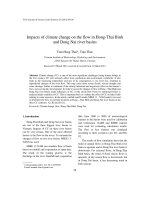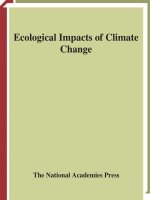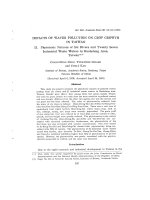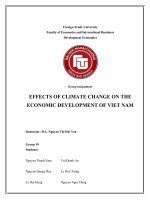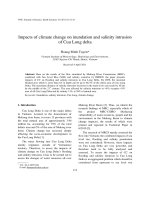Impacts of climate change on food security in Vietnam
Bạn đang xem bản rút gọn của tài liệu. Xem và tải ngay bản đầy đủ của tài liệu tại đây (1.32 MB, 83 trang )
UNIVERSITY OF ECONOMICS
HO CHI MINH CITY
VIETNAM
INSTITUTE OF SOCIAL STUDIES
THE HAGUE
THE NETHERLANDS
VIETNAM - NETHERLANDS
PROGRAMME FOR M.A IN DEVELOPMENT ECONOMICS
IMPACTS OF CLIMATE CHANGE ON FOOD
SECURITY IN VIETNAM
BY
HUỲNH THỊ NHI
MASTER OF ARTS IN DEVELOPMENT ECONOMICS
HO CHI MINH CITY, January 2013
UNIVERSITY OF ECONOMICS
HO CHI MINH CITY
VIETNAM
INSTITUTE OF SOCIAL STUDIES
THE HAGUE
THE NETHERLANDS
VIETNAM - NETHERLANDS
PROGRAMME FOR M.A IN DEVELOPMENT ECONOMICS
IMPACTS OF CLIMATE CHANGE ON FOOD
SECURITY IN VIETNAM
A thesis submitted in partial fulfilment of the requirements for the degree of
MASTER OF ARTS IN DEVELOPMENT ECONOMICS
By
HUỲNH THỊ NHI
Academic Supervisor
Ph.D NGUYỄN HỮU DŨNG
HO CHI MINH CITY, January 2013
TABLE OF CONTENTS
DECLARATION .............................................................................................................. i
ACKNOWLEDGEMENT .............................................................................................. ii
ABSTRACT ....................................................................................................................iii
LIST OF TABLES ......................................................................................................... iv
LIST OF FIGURES ........................................................................................................ v
ACRONYMS AND ABBREVIATIONS ...................................................................... vi
Chapter 1.......................................................................................................................... 1
INTRODUCTION ........................................................................................................... 1
1.1. PROBLEM STATEMENT .................................................................................... 1
1.2. RESEARCH OBJECTIVIVES .............................................................................. 3
1.3. RESEARCH QUESTIONS .................................................................................... 3
1.4. RESEARCH CONTRIBUTIONS .......................................................................... 4
1.5. ORGANIZATION OF THE STUDY .................................................................... 4
Chapter 2.......................................................................................................................... 6
LITERATURE REVIEW ............................................................................................... 6
2.1. BASIC CONCEPT AND DEFINITION ................................................................ 6
2.1.1. Greenhouse gases (GHGs) .......................................................................................... 6
2.1.2. Emissions..................................................................................................................... 6
2.1.3. Climate Change ........................................................................................................... 6
2.1.4. Climate Change Scenario ............................................................................................ 9
2.1.5. Sea Level Rises ......................................................................................................... 10
2.1.6. Food Security ............................................................................................................ 10
2.1.7. Scenario ..................................................................................................................... 11
2.1.8. Simulation ................................................................................................................. 11
2.2. THEORETICAL FRAMEWORK ....................................................................... 11
2.2.1. Theoretical Literature ................................................................................................ 11
2.2.2. Empirical Studies ...................................................................................................... 17
2.2.3. Conceptual Framework ............................................................................................. 24
2.3. CHAPTER REMARKS ....................................................................................... 26
Chapter 3........................................................................................................................ 26
CURRENT SITUATION OF FOOD DEMAND, FOOD SUPPLY AND CLIMATE
CHANGE IN VIETNAM ............................................................................................. 27
3.1. CURRENT SITUATION OF FOOD DEMAND, AND FOOD SUPPLY .......... 27
3.1.1 Paddy Production ....................................................................................................... 27
3.1.2. Domestic Rice Consumption and Export .................................................................. 32
3.2. CURRENT SITUATION OF CLIMATE CHANGE .......................................... 35
3.3. CHAPTER REMARKS ....................................................................................... 35
Chapter 4........................................................................................................................ 39
METHODOLOGY AND DATA.................................................................................. 39
4.1. METHODOLOGY ............................................................................................... 39
4.2. SOURCE OF DATA ............................................................................................ 43
4.3. CHAPTER REMARKS ....................................................................................... 44
Chapter 5........................................................................................................................ 45
DATA ANALYSIS AND RESULTS ........................................................................... 45
5.1. IMPACT OF CLIMATE CHANGE ON RICE YIELD IN MEKONG DELTA 45
5.2. CLIMATE CHANGE SCENARIOS AND FOOD SECURITY SCENARIOS IN
VIETNAM UP TO 2030 ............................................................................................. 49
5.3. CHAPTER REMARKS ....................................................................................... 58
Chapter 6........................................................................................................................ 59
CONCLUSIONS AND RECOMMENDATIONS ...................................................... 59
6.1. SUMMARY OF THE STUDY AND CONCLUSIONS ..................................... 59
6.2. RECOMMENDATIONS ..................................................................................... 60
6.3. LIMITATIONS AND FURTHER RESEASRCHES .......................................... 61
REFERENCES .............................................................................................................. 63
APPENDIX .................................................................................................................... 69
DECLARATION
I declare this is the scientific research of my own. Data collection and analysis in this
paper is truthful, not distorted. This paper is not copied from the others. In my research,
I have used some data from previous studies which were studied by official
organizations. For these data, I have already written the sources clearly below in tables
as well as in paper’s Appendix and References.
I hereby undertake responsibility for the contents of my thesis. And I certify that this
study has not already been submitted for any degree and is not being currently
submitted for any other degree.
Ho Chi Minh City, January 2013
Huynh Thi Nhi
i
ACKNOWLEDGEMENT
Fist of all, I would like to thank my supervisor, Dr. Nguyen Huu Dung for his
intellectual support and his wonderful inspiration. I am grateful for his support and
kindness in helping me at every stage of my research. His knowledge about rural
development and environment issues has helped me to understand and enjoy those
issues. The suggestions and comments from him are significant which was improved
my research. Without his understanding and encouragement, I would not complete this
paper. Secondly, my thanks go to Dr. Nguyen Van Ngai, who was given some hints for
my topic as well as methodology in the first step.
In addition, I also would like to thank Dr. Ha Thuc Vien and Dr. Tran Tien Khai who
taught me the deep knowledge of the economic environment as well as inspired me to
environment issues.
Finally, my thanks go to my family and my friends who were at my side and supported
to me throughout this program. I would not finished my course unless their
encouragements.
ii
ABSTRACT
This paper studies how climate change impacts on national food security. Econometric
model is used to estimate from the secondary data as pool data of Mekong Delta in
period 2001-2010. The Cobb-Douglas functional form is applied for the average yield
function. The result indicates that in Cobb-Douglass model, as the temperature rises by
1%, the estimated decrease the rice yield is 0.45% and the rice yield also decreases
0.15% on average when the precipitation increases 1%, holding all other factors
constant. The qualitative analysis and simulations with different scenarios are also
applied to build on Vietnam’s food security scenarios up to 2030. The findings show
that Vietnam has to face the lack of rice for consuming up to 2030 in IPSL-2030
climate change scenario. This country needs to add 4.2 million tons of rice to ensure
food security at the national level. Meanwhile, in GISS-2030 and MORNE-2030
scenarios, Vietnam is still ensure for domestic consume, and the surplus rice for
export in these two scenarios are 0.4 and 1.5 million tons, respectively.
iii
LIST OF TABLES
Table 2.1: Summary of Empirical Studies about Impacts of Climate Change on
Agriculture and Food Security........................................................................................20
Table 3.1: Paddy Yield by Regions of Vietnam, 1995-2010..........................................31
Table 3.2: Domestic Rice Consumption in Vietnam, 1995-2010...................................32
Table 3.3: Rice Export Volume of Vietnam, 1995-2010................................................33
Table 5.1: Descriptive Statistics of Data .......................................................................45
Table 5.2: Panel Unit Test Results..................................................................................47
Table 5.3: Estimation Results.........................................................................................47
Table 5.4: Average Annual Temperature increase in Degrees by Agro-ecological
Zones..............................................................................................................................49
Table 5.5: Average % Changes in Annual Precipitation by Agro-ecological Zones...50
Table 5.6: Rice Yield Change under Climate Change Scenarios...................................50
Table 5.7: Estimated Rice Planted Area versus Impact of Climate Change up to
2030................................................................................................................................51
Table 5.8: Forecasted Domestic Demand of Food in Vietnam up to 2030....................53
Table 5.9: Balancing Paddy Supply and Paddy Demand in Vietnam until 2030..........54
Table 5.10: Food Security Scenarios up to 2030 by CAP-IPSARD...............................55
Table 5.11: Climate Change Scenarios and Food Security Scenarios up to 2030........56
iv
LIST OF FIGURES
Figure 2.1: Global Warming and Changes in the Climate System ..................................8
Figure 2.2: Climate Change and Food Security..............................................................15
Figure 2.3: The Linkage between Climate Change and Food Security..........................25
Figure 3.1: Paddy Statistic in Vietnam, 1995-2010........................................................27
Figure 3.2: Cultivated Paddy Area by Regions of Vietnam, 1995-2010........................29
Figure 3.3: Distribution of Vietnamese Paddy Production (average 1995-2010)........30
Figure 3.4: Average Rice Consumption in Vietnam, 2000-2006...................................33
Figure 3.5: The Share Rice Exports of Vietnam in World Total, 1995-2010................34
v
ACRONYMS AND ABBREVIATIONS
CAP
Center for Agricultural Policy
CC
Climate Change
FAO
Foods and Agriculture Organizations of the United Nation
GHG
Greenhouse Gas
GISS
Goddard Institute for Space Studies
GSO
General Statistic Office of Vietnam
ICEM
International Centre for Environment Management
IFRC
International Federation of Red Cross and Red Crescent Societies
IFPRI
International Food Policy Research Institute
IMHEN
Vietnam Institute of Meteorology, Hydrology and Environment
IPCC
Intergovernmental Panel on Climate Change
IPSARD
Institute of Policy and Strategy for Agriculture and Rural Development
IPSL
Institute Pierre Simon Laplace
IRRI
International Rice Research Institute
MARD
Ministry of Agriculture and Rural Development of Vietnam
MORNE
Ministry of Natural Resources and Environment of Vietnam
NACCC
National Advisory Committee on Climate Change
NASA
National Aeronautics and Space Administration
NRCB
Natural Research Centre of Banana
OXFAM
Oxford Committee for Famine Relief
UNFCCC
United Nations Framework Convention on Climate Change
UNDESA
United Nations Department of Economic & Social Affairs
UNDP
United Nations Development Program
WB
World Bank
vi
Chapter 1
INTRODUCTION
1.1. PROBLEM STATEMENT
Up to now, climate change is one of the greatest challenges facing human beings. It
has become the concern as socio-economical and environmental problems in the
world. Indeed, climate change became global issue in recent years, negatively
impacted to all countries, especially in agriculture regions; threat crop failures, life
damage losses and other critical ecosystem vulnerabilities. In particular, agriculture
sectors have direct exposure and dependence on weather and other natural conditions.
Hence, climate change could pose serious issues. On the other hand, the challenges of
global food security through increasing population, accompanied by increased demand
for food. As predicted, the world population can be growth from 6.9 billion in 2010 to
8.3 billion in 2030 and to 9.1 billion people in 2050, but the majority occurs in
developing countries. Thus, food demand has to increase by 70% to meet the
population growth, in which the developing countries have doubled. At present,
enormous burden of feeding a global population is growing rapidly become more
severe due to the impact of climate change on food production (UNDESA, 2009).
According to United Nations Framework Convention on Climate Change (UNFCCC,
2007), Vietnam is the graded fifth in vulnerability under the impacts of climate
change. In which, Mekong Delta is one of the three most vulnerable Deltas in the
world as rising sea level, besides the Nile Delta in Egypt and the Ganges Delta in
Bangladesh. In East and South Asia, climate change will alter precipitation patterns,
increasing frequency of droughts and average temperatures, threatening fresh water for
agricultural production. In Sub-Saharan Africa, rainfall will be reduced by half in
2020. It is a threat for agriculture sector, and so it effect to food security all over the
world.
Consequently,
ensuring
food
security
is
increasingly
urgent.
The
1
Intergovernmental Panel on Climate Change (IPPC, 2007) has also estimated that
Vietnam will be seriously affected by changing of climate in the future.
In fact, Vietnam is among of the countries hardest hit by climate change through rising
sea levels, changing in rainfall and temperatures. According to Vietnamese Ministry of
Natural Resources and Environment (Climate change, Sea level rise scenarios for
Vietnam, MONRE, 2009), the change in climate would significantly affect over all
regions of Vietnam. “By the end of the 21st century, average temperature in Vietnam is
expected to increase about 2.30C; total annual rainfall and rainy season’s rainfall
would increase while dry season’s rainfall would decrease; sea level is expected to rise
about 75cm compared to the average for 1980-1999” (MONRE, 2009). If sea levels
rise by 1 meter, approximately 40% of the Mekong Delta, 11% of the Red River Delta
area and 3% of the other provinces in coastal areas will be flooded; 10-12% Vietnam's
population directly affected, and losses of about 10% of GDP (Tran Hong Ha,
MONRE, 2011). Meanwhile, the population of Vietnam was estimated more than 100
million people in 2020. It means that Vietnam has to raise the current food production
to ensure food security.
Furthermore, Vietnam’s climate, topography and long coastline makes Vietnam
particularly vulnerable to climate variability and natural disaster. The Vietnamese
coastline is about 3,260 km with the sea consists 1,000,000 km2. The natural area has
329,241 km2, of which 29% of land used for agricultural production (GSO, 2010). In
recent, Vietnam is the second largest rice exporter in the world. However, the country
still has about 1 million people, mainly ethnic minorities without enough food for their
living. Thus, food security is not only more serious for Vietnam but also for the rest of
the world by impacting of climate change.
In brief, climate change has narrowed the area of agricultural land which were
submerged a large portion of agricultural land in the low coastal plains, the Red Delta
and the Mekong Delta by rising sea levels. Besides, increasing temperatures, changing
2
weather and natural disasters lead to grow diseases and epidemics. Not only the
productivity and output have been threatened, but also the national food security as
well. It is the reason why the Vietnamese government and many Institutions had a lot
of programs and researches to adapt the climate change and food security. Based on
the available climate change scenarios which were conducted by researchers and
institutions as well as the previous findings, this paper studies the impacts of climate
change on food security in Vietnam with the simulation approach.
1.2. RESEARCH OBJECTIVIVES
The goal of this study is to examine how likely is the climate change may pose
impacts on food security based on MORNE’s climate change scenarios and food
security projects. This research has four specific objectives as follows:
(1) To understand the relationship between climate change and food security;
(2) To indicate the impact of climate change on rice yield in Mekong Delta in
period 2001-2010;
(3) To explore and estimate the impacts of climate change on food security in
Vietnam up to 2030, focusing on food supply side;
(4) To draw policy recommendations for food security in Vietnam.
1.3. RESEARCH QUESTIONS
To obtain the above objectives, this paper will attempt to answer the following
questions:
(1) How is the relationship between climate change and food security?
(2) How is the impact of climate change (such as rainfall changes, temperature
increases, etc.) on rice production in Mekong Delta region?
3
(3) How is the impact of climate change on food security in Vietnam up to 2030?
Among of predicted scenarios, which scenarios are suitable for Vietnam in
reality?
(4) What are policy implications to food security in the future?
1.4. RESEARCH CONTRIBUTIONS
This paper will forecast the impact of climate change on food security in Vietnam up
to 2030. In particular, it attempts to forecast the impact of climate change on food
security with simulations on different scenarios. In addition, this study also looks at
the food demand and supply based on government goals which is evident in the legal
documents. The findings may provide policy makers useful information in assessing
the feasibility of food security objectives under climate change, and in selecting the
appropriate policies to adapt the climate change and ensure the food security up to
2030.
1.5. ORGANIZATION OF THE STUDY
This paper consists of six parts, covering the major theme as impact of climate change
on food security. Chapter 1 provides the overview of the study. Chapter 2 presents the
literature review. Chapter 3 indicates the current situation of food demand and supply,
and climate change in Vietnam. Chapter 4 shows the methodology and data. Chapter 5
analyzes data and discusses the results. Finally, Chapter 6 concludes the paper and
provides some recommendations as well as the limitations of this research.
In detail, Chapter 1 raises the problem statement which is caused the theme for this
thesis. Based on the issue, impact of climate change on food security is studied. The
objectives and contributions of this study also present in the first part. Second, Chapter
2 presents basic concepts and definitions such as greenhouse gases, emissions, climate
change, climate change scenario, and food security. Theoretical literature and
empirical studies which related climate change and agriculture production aspect are
4
also presented. The finding of conceptual framework indicating the linkage between
climate change and food security is reviewed as well. Third, Chapter 3 shows and
analyzes the current situation of food demand and supply, and climate change. The
chapter begins with the analysis of paddy production as rice being the major food for
Vietnamese meal. This section investigates Vietnam’s paddy statistics in the period
from 1995 to 2010, including cultivated paddy area and paddy yields by regions of
Vietnam. In the demand side, this study evaluates domestic rice consumption and rice
exports volume of Vietnam. Regarding to the current situation of climate change, the
chapter mainly summarizes the analysis of climate parameters and sea level based on
observed data of MORNE. Climate is considered in this part as temperature, rainfall,
sea level rise, typhoon, cold front and drizzles. Next, Chapter 4 presents the
methodology and data where econometric model is used to estimate from the
secondary data which is adopted pool data of Mekong Delta in period 2001-2010. The
Cobb-Douglas functional form is applied for the average yield function. Methods for
analysis and simulations under different scenarios are also presented. And then,
Chapter 5 analyses and explains the results. The aim of this chapter is to show the
impact of climate change on food security up to 2030 with various climate scenarios.
Finally, Chapter 6 concludes the paper. It discusses the main findings as well as offers
some recommendations. The limitations of this research are also raised in the last
section.
5
Chapter 2
LITERATURE REVIEW
The chapter firstly defines the relevant concepts including climate change and food
security. Next, it shows theoretical literature on the linkage between the climate
change and food security. Cobb-Douglas Function and Simulation approach are laid
out. Then, it reviews some empirical studies. And finally, the conceptual framework
for this study is also presented in this chapter.
2.1. BASIC CONCEPT AND DEFINITION
2.1.1. Greenhouse gases (GHGs)
Greenhouse gases are gases that absorb long-wave radiation (infrared). These are
reflected from the earth's surface when illuminated by sunlight, then, dissipate heat
back to the earth and causing the greenhouse effect. Ordinarily, the prime greenhouse
gases in the Earth’s atmosphere are water vapor (H2O), carbon dioxide (CO2), nitrous
oxide (N2O), methane (CH4) and ozone (O3). (IPCC Glossary, 1995)
2.1.2. Emissions
Emissions are the release of GHGs and (or) their precursors and aerosols into the
atmosphere which over a specified area and a period of time. (IPCC Glossary, 1995)
2.1.3. Climate Change
Climate change is the change of climate states compared to average and climatic
fluctuations to maintain a longer period, typically some decades or longer. It may be
due to natural internal processes or external effects. Moreover, human activities were
altered the composition of the atmosphere or in land utilization. (IPCC Glossary, 1995)
Climate change occurs due to the natural variability in climate system. According to
the Intergovernmental Panel on Climate Change (IPPC, 2007) and Food and
6
Agriculture Organization of the United Nation (FAO, 2008), greenhouse gases to the
atmosphere was one of the major causes. This was proposed by Joseph Fourier in
1824. After that, in 1896, Svante Arrhenius investigated quantitatively. These factors
determine the greenhouse gas emission such as economic growth, population,
consumption, energy sources, technology transfer and land use, etc. (IPCC, 2007).
Among of them, water vapor which causes about 36-70% of the greenhouse effect,
carbon dioxide (CO2) about 9–26%, methane (CH4) about 4–9%, ozone (O3) about 3–
7%, chlorofluorocarbons (CFCs) and nitrous oxide (N2O) were the rest cause. Wigley
and Jones (1981) concluded that the effects of CO2 on climate is available and by this
time, atmospheric CO2 concentrations may become high and will be higher in the
future which was an important cause of climate change.
7
Figure 2.1: Global Warming and Changes in the Climate System
Changes in cryosphere
Changes in average weather
Glacier melt
Permafrost melt
Loss of sea ice
conditions
Atmosphere
Global warming
Increasing
accumulation of
greenhouse gases
traps more heat in
the atmosphere
Higher global mean and
maximum surface air
temperatures
Hydrosphere
Higher global mean and
maximum sea surface
temperatures
Changes in hydrosphere
Changes in ocean circulation
Changes in patterns of water flow in glacier-fed streams
Changes in recharge rates for underground aquifers
Changes in sea salinity
Saltwater intrusions
Sea-level rise
Shallower lakes
Higher rates of evaporation
and evapotranspiration
Changes in degree of humidity
and atmospheric pressure
Changes in cloud cover
Higher global mean
precipitation
Changes in frequency,
duration intensity and
geographic distribution of
rainfall and snowfall
Increased frequency, duration
and intensity of droughts
Changes in wind patterns
Greater seasonal weather
variability
Changes in frequency,
duration and intensity of
extreme weather events
Displacement of climatic
zones
Source: FAO/NRCB, 2008
Changes in biosphere
More luxuriant plant
growth
Species shifts uphill and
towards polar regions,
resulting in changed
species composition of
nature habitats
Changes in suitability of
land for arable crops, tree
crops, pasture crops,
grazing and human
habitation
Changes in star/end of
growing season
Displacement of agroecological zones
Changes in lithosphere
More soil erosion
Changes in pattern of
sedimentation after
flooding
Changes in shorelines of
coasts and lakes
8
2.1.4. Climate Change Scenario
Climate change scenario is the scientific assumption and reliability in future evolution,
of which the relationship between socio-economic development, GDP, greenhouse gas
emissions, climate change and sea level rises (IPCC, 2007). The scenarios reported by
IPCC (2007) are as follows:
A1 Family: Scenario characteristics are rapid economic growth, global
population reaches the peak in 2050 and declines thereafter, rapid introduction
of new technologies and more efficient of these, convergence of world-income,
way of life and among regions, strong cultural exchanges and social
interactions. (IPCC, 2007)
Based on technological development, A1 scenario divides into three groups. All
these are A1F1 (High emission scenario) with an intensity on fossil intensive,
A1B (Medium emission scenario) with an intensity on a balance across all
energy sources and A1T (Low emission scenario) with an intensity on nonfossil energy sources. (IPCC, 2007)
A2 Family: Scenario characteristics are heterogeneous world, self-reliance and
preservation of nations, continuously increasing population in the 21st century,
regionally-oriented economic development, technological change, slow per
capita economic growth (High emission scenario, similar to A1F1). (IPCC,
2007)
B1 Family: Scenario characteristics are rapid economic growth as in A1, but
with changes toward a service and information economy, global population
reaches the peak in 2050 and declines thereafter, reduces in material intensity
and introduces clean and resources efficient technologies, emphasizes on global
solutions to economic, social and environmental sustainability (Low emission
scenario, similar to A1T). (IPCC, 2007)
B2 Family: Scenario characteristics are continuously increasing population, but
at a rate lower than A2, emphasizes on local rather than global solutions to
9
economic, social and environmental sustainability, economic development with
intermediate levels, less rapid and more diverse technological change than in
B1 and A1 families (Medium emission scenario, similar to A1B). (IPCC, 2007)
2.1.5. Sea Level Rises
Sea level rise is the surge of ocean water in worldwide, which does not include tides,
storm surges. Sea level rise at a certain location may be higher or lower than the global
average because of differences in ocean temperature and other factors. (IPCC
Glossary, 1995)
2.1.6. Food Security
Food security is a situation that exists when all people, at all times have secure access
to sufficient, safe and nutritious food for normal growth and development, for an
active and healthy life. (IPCC Glossary, 1995)
“Availability at all times of adequate world food supplies of basic foodstuffs to sustain a
steady expansion of food consumption and to offset fluctuations in production and prices”
(World Food Summit, 1974)
“Ensuring that all people at all times have both physical and economic access to the basic
food that they need” (FAO, 1983)
“Access of all people at all times to enough food for an active, healthy life” (World Bank,
1986)
“Food security, at the individual, household, national, regional and global levels [is achieved]
when all people, at all times, have physical and economic access to sufficient, safe and
nutritious food to meet their dietary needs and food preferences for an active and healthy life”
(World Food Summit, 1996)
“Food security is a situation that exists when all people, at all times, have physical, social and
economic access to sufficient, safe and nutritious food that meets their dietary needs and food
preferences for an active and healthy life” (State of Food Insecurity, 2001)
10
2.1.7. Scenario
Scenario is a possible description of how the future may develop which based on a
coherent and consistent set of assumptions about driving forces and key relationships.
(IPCC Glossary, 1995)
2.1.8. Simulation
Simulation is a form of predictions given a set of prediction schemes based on
different assumptions about future scenarios. (IPCC Glossary, 1995)
2.2. THEORETICAL FRAMEWORK
2.2.1. Theoretical Literature
2.2.1.1. The Linkage between Climate Change and Food Security
The linkages between climate change and food security have been examined and
documented in literature. For the most part, this relation is the impact of climate
change on productivity. Therefore, food supply is influenced as a link. The causes of
climate change are also considered to explain clearly. The increase in average
temperature of Earth due to emissions of carbon dioxide and other gases into the
atmosphere had caused the change of global climate. Over the past 100 years, Earth's
average surface temperature increased by about 0.8°C, especially in last three decades.
During the 20th Century, the average temperature of Earth rose 0.6°C and predicted
that it will rise between 1.8° and 4.0° Celsius in during 21st Century (IPCC, 2007).
Most of the scientists found that the increase in concentrations of greenhouse gases is
the cause, which were produced by human activities (IPCC AR4 SYR, 2007).
In the case of Vietnam, agriculture accounts for a large proportion of greenhouse gas
emissions. Actually, rice cultivation and livestock account for about 43% (MORNE,
2011). Thus, the climate change and agriculture production have an interaction
together. In the long run, the climate change could impact on agriculture in many
ways. It could affect the yield, in term of quality and quantity of crops. Besides,
11
agriculture practice will be influenced due to fertilizers, herbicides, insecticides and
irrigation. In another way, the environment will be effected through frequency and
intensity of soil drainage, soil erosion, crop diversity declined as well. Furthermore,
the loss and gain of cultivated lands also lead to rural landscape change.
As a result, greenhouse gases do make global warming and lead to change the climate.
FAO and NRCB (FAO/NRCB, 2008) showed that climate change through five
aspects: CO2 fertilization effect, increase in global mean temperatures, gradual
changes in precipitation, increase in frequency and intensity of extreme weather
events, and greater weather variability. This leads to change in food system assets then
change in food system activities. Finally, four components of food security as
availability, accessibility, utilization and system stability were changed by climate
change indirectly (FAO, 2008).
Indeed, the climate change has become the global environment issue. This problem is
more dangerous deal with developing countries. According to World Bank (WB,
2010), climate change is expected to hit developing countries the hardest. Changes in
rainfall patterns, increased in temperature, more frequent weather and rising sea level
are the causing of risks for agriculture, food and water supplies. The impactions of
climate change on agriculture production and human life were occurred day by day. In
the past and in the present, many of the people have to die of hunger or to suffer
hunger. This problem is more serious for the poor people. In the future, they will still
face with the hunger due to climate change on agriculture production. Hence, much of
the existing research has focused on the potential agriculture impact and food security
implications.
For instance, in “Effects of Climate Change on Food Production” of Parry and
Swaminathan (1992) showed that global climate change will boost the pressure on
agriculture system. The yield will be declined meanwhile the food demand is growing
rapidly. Consequently, they effected on world food supply and food security. At the
12
same time, Downing (1992) illustrated some evidences about global change and
vulnerability to hunger. The index of food security in developing countries, resource
pressure and risk of climate change were presented in this research. Chen (1990) found
that the global agriculture, the environment and food security have linkages together.
He highlighted these linkages in the past, present and future. This was presented in the
article “Global Agriculture, Environment and Hunger”. In particular, Sinha et al
(1988) argued the food supply in smaller countries will be more affected by climate
change than the larger countries.
In the same token, Kwon and Kim (2008) examined the relationship between
productivity and climate change of which rice yield was illustrated. They applied nonparametric and semi-parametric models for their study. The result showed that rice
yield and climate change are related. In respect, rice yield was positive with
temperature and negative with rain fall. Besides, the exiting was a non-linear
relationship between rice yield and weather variables. Nevertheless, they only focused
on average rice yield change over weather conditions. They did not consider crop yield
variability and weather conditions corresponding. For this reason, McCarl and
Schimmelpfennig (2004), Chang and Chen (2005), Devadoss and Isik (2006)
discussed this aspect. They demonstrated that weather variables affect average crop
yield and the variability as well. The average crop yield and yield variability are
mixed. Some are positive and some are negative which are based the characteristics of
crops and physical growing locations. These researchers concluded that the average
crop yield in hotter and drier weather conditions is lower and the variability is also
larger.
In the case of Vietnam country and regions in detail, climate change is a serious
challenge that Mekong Delta and Red Delta are low lying. Thus, they are the most
regions affected when flooding occurs as well as salinity and other adverse weather
phenomena. Major causes of climate change are due to the increase of physical
activities generate GHG emissions, the excessive exploitation of forest resources,
13
marine ecosystems, coastal and other land (IMHEN, 2011). Mekong Delta is the
country's largest rice granary and aquaculture region. It produces about 50% of
country's rice output and 52% of aquatic products (GSO, 2010). Based on the findings
of Bingxin Yu, Clemens Breisinger, Nguyen Manh Hai and Tingju Zhu (2010),
annual rice production may be reduced by 2.7 million tons by 2050 under climate
change. Crop yield reductions under climate change vary widely across agroecological zones. The yield decline is estimated to be 4.3–8.3% by 2050 in the
Mekong Delta.
In conclusion, the interaction between biogeophysical and human environments lead to
the production, processing, distribution, preparation and consumption of food. Climate
change can be “due to natural variability or as a result of human activity” (IPCC
2007). According to FAO, food systems involve food availability, food access and
food utilization. And so, the resulting in food systems ensure for food security.
14



